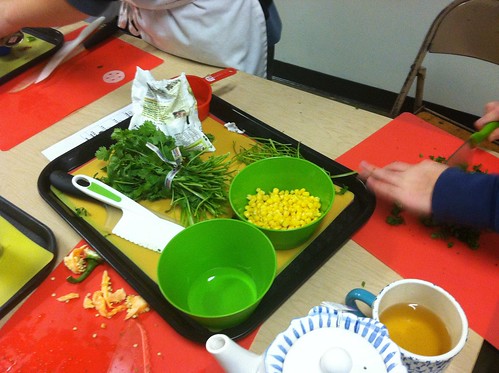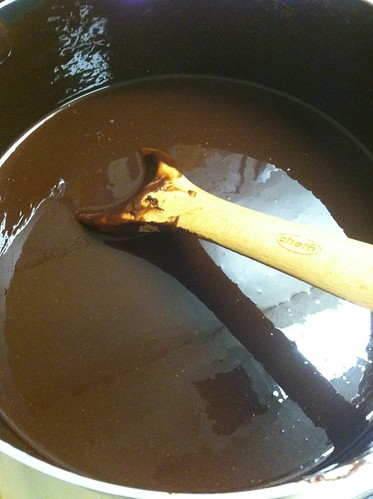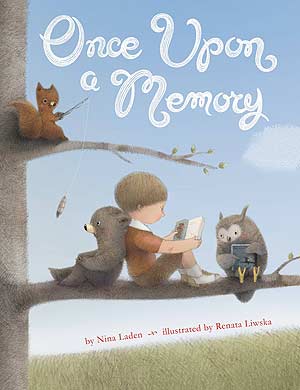When I asked the kids in our class how many apple varieties they could name, there were just two: Red Delicious and Granny Smith. Our modern food system has served to decrease the variety of our diets, with enormous consequences to our health and planet. It makes the necessity of classes like Farm to Table very real to me.
It was a privilege on Tuesday to welcome a kindred spirit, Kim O'Donnel, the food journalist, cookbook author, and trained chef, to teach two recipes from her bestselling vegetarian book, "The Meat Lover's Meatless Celebrations."
I thought I was well-prepared. Earlier in the week, our program was given a gift card from Metropolitan Market (thank you, wonderful neighborhood grocer). I shopped at their Uptown store for ingredients, shopped in my kitchen for some spices, and arrived at school in plenty of time to make photocopies, heat water for tea, and begin the mise en place (one of the fancy terms the kids are learning). When Kim arrived, we had a relaxed chat, and I was congratulating myself on having everything ready.
Then she asked, where is the tahini? Yikes! It was on my list but I must have blanked while shopping. I nabbed my purse and dashed to Safeway, two blocks away. Ten minutes and an excruciatingly slow "express" line later, all was well -- until we tried to open the can. The only opener we could find was no match for the deep lid. We took turns. We laughed. We turned the can over and attacked if from the bottom. No luck. Was the entire lesson going to be foiled by an impenetrable tahini can? I was about to try the "Russian hacker method" involving concrete and muscle (very nifty video here) when Phyllis arrived and succeeded with a knife. Thank you, Phyllis!

Crisis averted, Kim acquainted the kids with sweet potatoes, often mislabeled as yams in grocery markets. There are thousands of varieties, but the red-fleshed Garnet or Ruby types are common here, and as tasty as they are beautiful. Inexpensive, low in calories, rich in Vitamin A, beta-carotene, manganese, copper, and potassium, sweet potatoes are a superfood. They also have a low-glycemic index, making them popular for diabetic, macrobiotic, and Paleo diets (without the Thanksgiving marshmallow topping, of course).
 Kim had pre-roasted the sweet potatoes for her recipe, giving us an opportunity to discuss the energy consumption of different appliances. Microwaves can use one third to one half the energy of conventional ovens, and make a good alternative for some foods. (Toaster ovens are another good alternative.) While a food's energy "footprint" is typically discussed in terms of the fossil fuels it requires to get from seed to store, there is also a footprint in getting it to the table, and choosing the right tool for the job can reduce energy costs and impact.
Kim had pre-roasted the sweet potatoes for her recipe, giving us an opportunity to discuss the energy consumption of different appliances. Microwaves can use one third to one half the energy of conventional ovens, and make a good alternative for some foods. (Toaster ovens are another good alternative.) While a food's energy "footprint" is typically discussed in terms of the fossil fuels it requires to get from seed to store, there is also a footprint in getting it to the table, and choosing the right tool for the job can reduce energy costs and impact.The kids had fun preparing and eating the hummus along with slices of fresh jicama and apple.
Then came the main dish. With Chloe taking the lead, the kids took turns scraping the skin off ginger (clever trick with a spoon), cleaning out the squash, tasting fennel seeds, and using a citrus zester (getting only the rind, not the bitter pith).
As the delicata and rice cooked, we turned our attention to pesticides, organic farming, and "beyond organic." Kim explores these topics regularly, and gave a good case for buying local foods in season, reinforcing the themes in the Nourish documentary.
I introduced the "Dirty Dozen" list, published annually by The Environmental Working Group. It lists produce that tests highest and lowest for pesticides (curiously, sweet potatoes, unlike conventional potatoes, test low, as do onions). Because organic foods are often more expensive, the budget-conscious consumer can use this information to decide where to spend their food dollars. Each student got a copy to take home and put on the fridge, or in a parent's wallet.
Of course, foods available from local farms are often "better than organic" (going beyond the federal standards). These are common at farmers markets and through CSA's, or Community Supported Agriculture, the source of many "food boxes" that arrive on Seattle porches during the week. (Mine is from Local Roots Farm, and happens to be heavy this week with . . . delicata squash.)
It took longer than expected for the squash to soften in Cranky Oven, but when Kim deemed it ready, we hastily filled it, cut it, and served it up, while Plate Lead Emma set a pretty table. Joe, our Gratitude Lead, gave a warm thank you to Kim and the farmers who grew our ingredients. It was a fun and tasty lesson. Mary snapped this photo (missing a few) of our merry band saying "DELICATA!"
Next week, McClure has parent-teacher conferences and there is no class. The following week, Chef Lesa Sullivan-Abajian is coming to walk us through soups and salads. Or something the kids have never tried. The future looks bright.
 Sweet Potato Hummus
Sweet Potato Hummus
From Kim O’Donnell’s The Meat Lover's Meatless CelebrationsIngredients:
- 2 pounds orange-fleshed sweet potatoes (also sold as garnet or jewel yams)
- 1 medium-size yellow onion
- Olive oil, for brushing
- 1 clove garlic, minced
- 2 tablespoons tahini
- 1⁄4 teaspoon paprika or other medium-heat ground chile pepper
- 1⁄2 teaspoon salt
- 2 to 3 tablespoons freshly squeezed lemon juice (about 1⁄2 medium-size lemon)
Directions:
- Preheat the oven to 400°F.
- Wash and scrub the sweet potatoes. Cut into 3- to 4-inch pieces, regardless of the width. Keep the skins on.
- Slice the onion in half and peel. Brush the onion and sweet potatoes with olive oil and place in a baking dish in a single layer. Cover with foil and roast for 1 hour; the sweet potatoes should be extremely tender.
- Let cool for about 10 minutes. Peel off the skins of the sweet potatoes.
- Place all the roasted vegetables in the bowl of a food processor or heavy-duty stand blender and puree. Add the garlic, tahini, paprika, and salt and blend. Then gradually add 2 tablespoons of the lemon juice and taste. Add more as needed.
- Serve at room temperature with chopped fruits and vegetables: apples, bell peppers, celery, endive, jicama, and pears are all great dipping companions.
- Keeps well in an airtight container in the refrigerator for at least 3 days. The garlic flavor deepens with time.
Delicata Boats with Red Rice Stuffing
- 1 ½ cups water
- 1 cup Bhutanese red rice (Plan B: long-grain Wehani; cooking times and liquid amounts may vary)
- 3 to 4 delicata squash (about 1 pound each)
- ⅛ cup olive oil, plus extra for brushing
- ¼ teaspoon salt, plus more to taste
- Freshly ground black pepper
- ½ cup fresh flat-leaf parsley, chopped
- ¼ cup unsalted shelled pistachios, chopped (Other options: walnuts, almonds, or pecans)
- ⅓ cup dried cranberries or cherries, chopped
- 1 teaspoon fennel seeds
- 1 teaspoon peeled and minced fresh ginger
- Zest of ½ lemon or orange, plus 1 or 2 squeezes of the juice
- ⅛ teaspoon ground chile pepper of choice
Directions:
- Bring the water and the rice to a boil in a medium-size saucepan. Lower the heat to low, cover, and cook at a simmer, 20 to 25 minutes. The rice will be done when water is absorbed and grains are tender to the bite.
- Preheat the oven to 400°F and line a baking sheet with parchment paper. Trim both ends of each squash and slice in half lengthwise. Scoop out and discard the seeds and the attached pulp. Brush both sides of the squash with the olive oil, and season the inside to taste with salt and pepper.
- Roast until easily pierced with a fork, about 30 minutes, and remove from the oven. Lower the oven heat to 350°F.
- While the squash roasts, make the filling: Transfer the rice to a large mixing bowl and add the ⅛ cup of olive oil, and the parsley, nuts, dried fruit, fennel seeds, ginger, citrus zest, and chile pepper. Stir until the rice is coated with the oil and the mixture is well mixed. Add the ¼ teaspoon of salt, stir, taste, and reseason if necessary.
- Fill each squash half with about ¼ cup of the filling. Return to the oven and heat for about 15 minutes, until the rice is warmed through.
- Serve immediately, or lower the oven temperature to 225°F, cover with foil, and hold until ready to serve.


![IMG_0750[1]](http://farm6.staticflickr.com/5512/10889688816_7732e25764.jpg)

![IMG_0743[1]](http://farm3.staticflickr.com/2867/10889780584_9a80e817cd.jpg)





